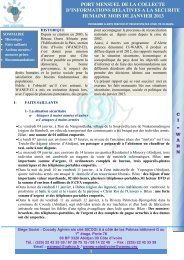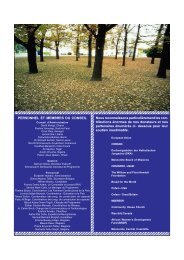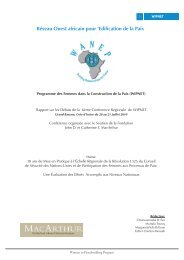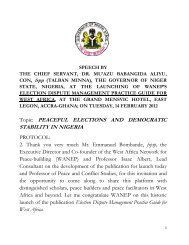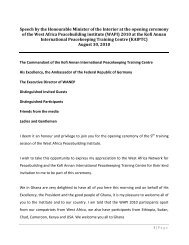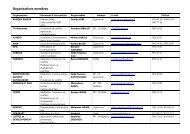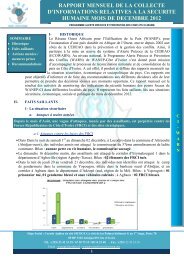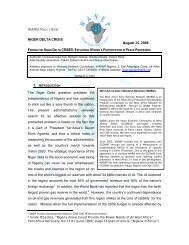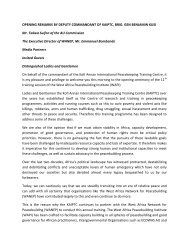DEVELOPMENT AND IMPLEMENTATION of National Action Plans ...
DEVELOPMENT AND IMPLEMENTATION of National Action Plans ...
DEVELOPMENT AND IMPLEMENTATION of National Action Plans ...
You also want an ePaper? Increase the reach of your titles
YUMPU automatically turns print PDFs into web optimized ePapers that Google loves.
2. Reiterates its demand for the complete cessation with immediate effect by all parties toarmed conflict <strong>of</strong> all acts <strong>of</strong> sexual violence;3. Encourages the Secretary-General to include in his annual reports submitted pursuantto resolutions 1820 (2008) and 1888 (2009) detailed information on parties to armedconflict that are credibly suspected <strong>of</strong> committing or being responsible for acts <strong>of</strong> rapeor other forms <strong>of</strong> sexual violence, and to list in an annex to these annual reports the partiesthat are credibly suspected <strong>of</strong> committing or being responsible for patterns <strong>of</strong> rapeand other forms <strong>of</strong> sexual violence in situations <strong>of</strong> armed conflict on the Security Councilagenda; expresses its intention to use this list as a basis for more focused United Nationsengagement with those parties, including, as appropriate, measures in accordance withthe procedures <strong>of</strong> the relevant sanctions committees;4. Requests the Secretary-General, in accordance with the present resolution and takinginto account its specificity, to apply the listing and de-listing criteria for parties listed inhis annual report on sexual violence in armed conflict consistent with paragraphs 175,176, 178, and 180 <strong>of</strong> his report A/64/742-S/2010/181;5. Calls upon parties to armed conflict to make and implement specific and time-boundcommitments to combat sexual violence, which should include, inter alia, issuance <strong>of</strong>clear orders through chains <strong>of</strong> command prohibiting sexual violence and the prohibition<strong>of</strong> sexual violence in Codes <strong>of</strong> Conduct, military field manuals, or equivalent; andfurther calls upon those parties to make and implement specific commitments on timelyinvestigation <strong>of</strong> alleged abuses in order to hold perpetrators accountable;6. Requests the Secretary-General to track and monitor implementation <strong>of</strong> these commitmentsby parties to armed conflict on the Security Council’s agenda that engage inpatterns <strong>of</strong> rape and other sexual violence, and regularly update the Council in relevantreports and briefings;7. Reiterates its intention, when adopting or renewing targeted sanctions in situations <strong>of</strong>armed conflict, to consider including, where appropriate, designation criteria pertainingto acts <strong>of</strong> rape and other forms <strong>of</strong> sexual violence; and calls upon all peacekeepingand other relevant United Nations missions and United Nations entities, in particularthe Working Group on Children and Armed Conflict, the Special Representative <strong>of</strong> theSecretary General for Children and Armed Conflict, and the Special Representative <strong>of</strong> theSecretary-General on Sexual Violence in Conflict, to share with relevant United NationsSecurity Council Sanctions Committees, including through relevant United Nations SecurityCouncil Sanction Committees’ monitoring groups and groups <strong>of</strong> experts, all pertinentinformation about sexual violence;8. Requests the Secretary-General to establish monitoring, analysis and reporting arrangementson conflict-related sexual violence, including rape in situations <strong>of</strong> armed conflictand post-conflict and other situations relevant to the implementation <strong>of</strong> resolution1888 (2009), as appropriate, and taking into account the specificity <strong>of</strong> each country,that ensure a coherent and coordinated approach at the field-level, and encouragesthe Secretary-General to engage with United Nations actors, national institutions, civilsociety organizations, health-care service providers, and women’s groups to enhance48



![English [266KB] - West Africa Network for Peacebuilding](https://img.yumpu.com/50460007/1/184x260/english-266kb-west-africa-network-for-peacebuilding.jpg?quality=85)
